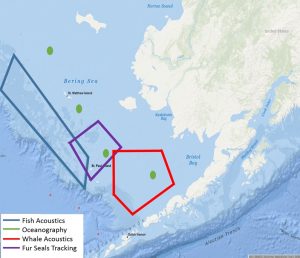
The innovative Saildrones, developed by Saildrone Inc, have once again been deployed to the Bering Sea, taking the place of manned vessels to gather information from areas that are generally inaccessible to full-sized research vessels, and are able to operate in a more cost-effective way.
With the generous support of the Marine Mammal Commission, NOAA, University of Washington, the Joint Institute for the Study of the Atmosphere and Ocean, Saildron, Simrad, and Greenridge scientists and engineers have set out to test the new technology to “continue to collect near real-time oceanographic data for U.S waters that will enable scientists to track environmental changes that may be occurring there; attempt to locate and gather acoustic data on marine mammals, among them the rarest whale inhabiting U.S. waters, the North Pacific right whale; test the use of a small-scale acoustic device that emits sound waves underwater to gather hard to obtain information on remote spawning areas for Alaska’s most important commercial fish stock; walleye pollock; and conduct detailed prey surveys within the foraging range of a declining population of northern fur seals,” NOAA reported in a release.[xyz-ihs snippet=”adsense-body-ad”]
Two Saildrones departed from Dutch Harbor less than two weeks ago and have been at sea for 11 days and have already covered 277 nautical miles gathering information as they travel from 2 knots to as fast as 5.2 knots, taking more than 85,000 measurements a day. The data gathered is immediately transmitted to shore.
This is the second year that the wind and solar-powered, carbon fiber unmanned “windsurfers” have taken to the Bering Sea to gather data. During last year’s mission, Saildrone SD-126 covered 4,137 nautical miles, while SD-128 sailed 4,393 nautical miles before successfully returning to Dutch Harbor after 97 days at sea.

During that mission, the Saildrones compared measurements from its equipment and existing NOAA assets, sampled retreating ice edges, locating salinity and thermal boundries near the ice, and completed a near-shore survey of the Yukon Delta.
This year, NOAA Fisheries Alaska Fisheries Science Center plans to use a modified acoustical tag to listen for marine mammals, including the rare North Pacific Right Whale, of which only 30 are believed to be in existence. It is hoped that the Saildrones will be able to detect the full range of these whales, their full range is currently unknown.
Also to be tested this year is low-power echo sounders to detect fish underwater. That data will be compared to echo sounding observations made by the research vessel Oscar Dyson to see how effective this new equipment will be for monitoring fish populations.
“We have high hopes for this mission – that it could mark a new chapter in ocean research,” said Christopher Sabine, director, NOAA Research’s Pacific Marine Environmental Laboratory. “Last year, we successfully implemented a 3-month testbed Saildrone mission in the Bering Sea to remotely collect data on physical oceanographic conditions via satellite in near real-time. This summer, we are testing other new technologies in the hopes of demonstrating their efficacy for remotely collecting critical biological data.”
“As pioneers in this new research frontier we’re seeking to discover more cost-effective ways to augment our existing research efforts and gather additional biological information in places that are difficult to navigate with a full-sized research vessel,” said Douglas DeMaster, research and center director, NOAA Fisheries’ Alaska Fisheries Science Center.
Throughout this year’s mission, viewers can follow the Saildrones’ progress by going to NOAA Research’s Pacific Marine Environmental Laboratory Innovative Technology for Arctic Exploration website and NOAA Fisheries’ Alaska Fisheries Science Center website. [xyz-ihs snippet=”Adversal-468×60″]
